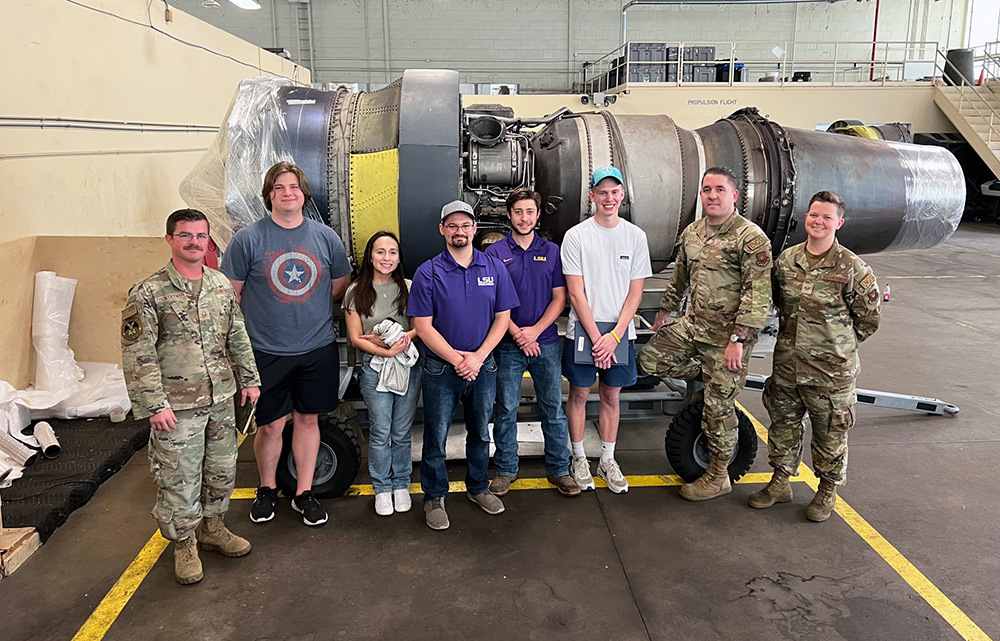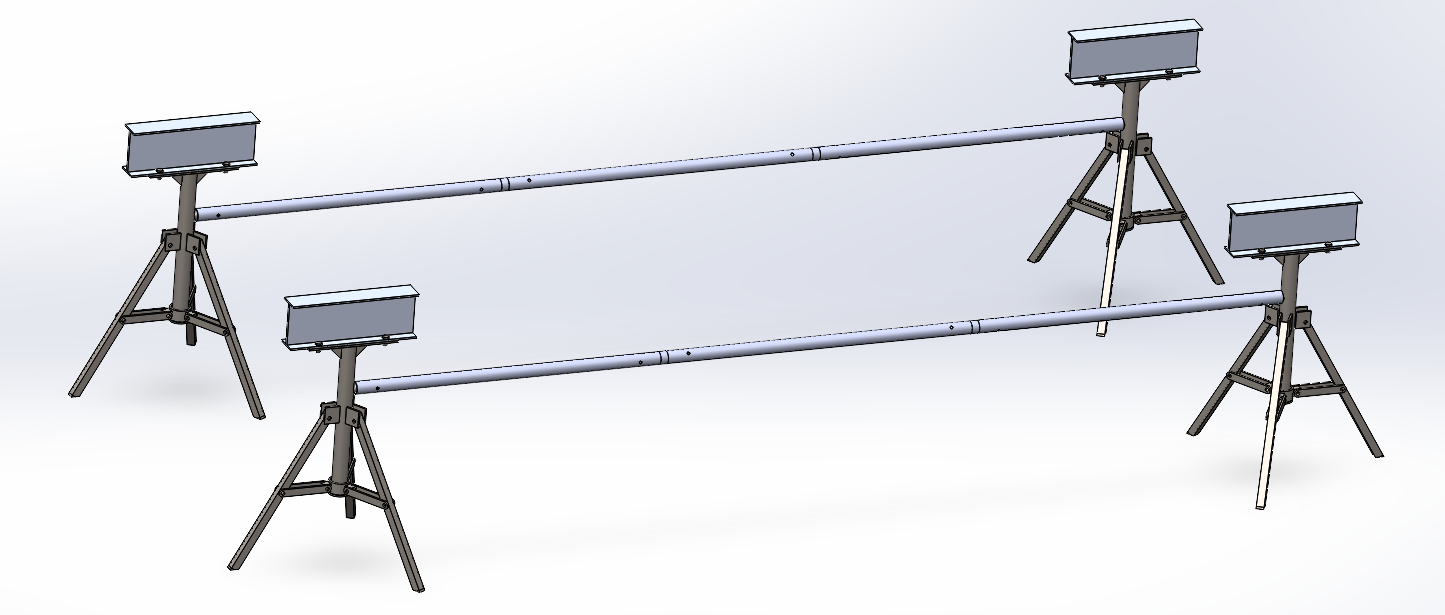Mechanical Engineering Seniors Design Equipment for B-52s at Barksdale AFB
 May 10, 2024
May 10, 2024
BATON ROUGE, LA – As part of their senior capstone project, six LSU Mechanical Engineering seniors have been working with Barksdale Air Force Base in Bossier City, La., to design an apparatus that will enable airmen to more easily work on or change out the engines on their B-52 bombers. Considering Barksdale AFB houses 26 B-52s, and each B-52 has eight engines, the students’ design should definitely come in handy.
Hannah Beene of Cyber Innovation Center, an innovation arm of the Air Force Global Strike Command Office of the Chief Scientist headquartered at Barksdale AFB, has been the point of contact between the LSU students and Barksdale AFB.
“Our role is to further AFGSC’s mission by fostering innovation and collaboration between industry, academia, business, and government to meet technology challenges,” Beene said.
When ME seniors Vaughn Bell of Ponchatoula, La.; Seth Chiasson of Denham Springs, La.; Matthew Day of Slaughter, La.; Sydney Gambino of Madisonville, La.; Stephen Freemen of Katy, Texas; and Ryan Purvis of Mandeville, La.; saw they had an opportunity to work on a project involving a B-52, they jumped at the chance.
“When it came time to choose my capstone project, I was excited as soon as I saw B-52 on the project list and immediately knew that was my top choice,” Bell said.
In October 2023, the students traveled to Barksdale AFB to see the B-52 engine in person and take measurements and photos to help them design their engine stand. The Air Force’s request was that they design something lighter and more compact than their current stand, which resembles a boat trailer and takes up much-needed room on the C-17 plane that flies alongside the B-52, carrying necessary cargo such as two spare engines.
The students’ design consists of four 3-ft.-high jack-stands that form a 4.5-ft. by 10.5-ft. rectangle supporting four aluminum I-beams on each corner and two long steel tubes that will hold two 80-lb. adapters a little more than 10 ft. apart that ultimately touch and support the engine. The whole stand holds up to 6,000 lbs., the estimated weight of a single B-52 engine.
 “The engine has very specific points where it can be attached to the adapter, so our
design must support the weight of the engine and interface with the adapter,” Bell
said.
“The engine has very specific points where it can be attached to the adapter, so our
design must support the weight of the engine and interface with the adapter,” Bell
said.
The students tested their stand at Reeb Rigging in Baton Rouge, where they were able to load 6,000 lbs. on their stand. The students also worked with Brock Group in Port Allen, which did some welding on the stand while the students themselves cut the materials to size in the LSU Advanced Manufacturing and Machining Facility (AAMF) across from Patrick F. Taylor Hall.
The team also performed a timed test to make sure its stand could be assembled in 15 minutes or less. When disassembled, the entire stand fits into a 24x60x24-inch D box that goes on the C-17 plane to hold a damaged engine if it needs to be replaced. While the C-17 carries a spare engine for the left and right side of the B-52, the B-52 itself carries eight engines at a time (up to 48,000 lbs.) in pods supported by four pylons beneath the wings’ leading edge. Their placement allows them to work as wing fences and delay the onset of a stall.
What makes the B-52 so unique is its size and function. The 185-ft. wide plane weighs 185,000 lbs. and was designed and built by Boeing for the U.S. Air Force in the 1950s. Its purpose was to carry nuclear weapons during the Cold War era, though NASA used it for 40 years as an air-launch and testbed aircraft. The B-52’s ability to stay in the air for more than 72 hours at a time, along with its excellent performance at high subsonic speeds, are why the USAF still uses the B-52 today.
“What I’ve enjoyed most about this project is getting the chance to say I’ve designed and worked on something for the B-52 engine,” Freeman said. “I don’t know who wouldn’t find that interesting.”
Like us on Facebook (@lsuengineering) or follow us on X (formerly Twitter) and Instagram (@lsuengineering).
###
Contact: Libby Haydel
Communications Manager
225-578-4840
ehaydel1@lsu.edu
Latest College of Engineering News
- LSU Computer Science Student Builds Interactive Lobby ExperienceMay 10, 2024BATON ROUGE, La. – The lobbies of LSU's Music & Dramatic Arts Building, School of Music Building, and Tiger Band Hall will soon feature a helpful new interactive digital kiosk experience for students and patrons alike, built by LSU College of Engineering undergraduate student Caleb Langley.
- LSU Electrical, Computer Engineering Seniors Design Virtual Lab for Remote ExperimentsMay 13, 2024BATON ROUGE, LA - As part of their senior capstone project, four LSU Electrical and Computer Engineering seniors designed a virtual lab that will allow LSU Mechanical Engineering students to conduct pipe-flow experiments from a remote location. The project's sponsor, LSU Mechanical and Industrial Engineering Department Chair and Professor Dimitris Nikitopoulos, thought of the project when students were stuck at home during the pandemic. The group's efforts are funded by Chevron.
- College of Engineering Honors Five at Evening of Engineering Excellence EventMay 8, 2024BATON ROUGE, LA - The LSU College of Engineering recently held its first Evening of Engineering Excellence event on April 25, inducting several new members into its Society for Engineering Excellence and Hall of Distinction.
- LSU Mechanical Engineering Instructor Creates ASPIRE Course for EducatorsMay 7, 2024BATON ROUGE, LA - Look! Up in the sky! It's a bird! It's a plane! It's...a drone. Drones are literally taking off and LSU Mechanical Engineering Senior Instructor Andrew Becnel wants students to keep up. Becnel, who is a graduate of LSU's Mechanical Engineering program and has a master's degree and Ph.D. in aerospace engineering from the University of Maryland, understands the importance of drone technology, especially in Louisiana.
- LSU Research Team Working to Increase Supply of Affordable, Resilient Housing in High-Risk AreasMay 6, 2024BATON ROUGE, LA - With hurricane season around the corner, a team of LSU researchers is exploring the feasibility of FORTIFIED® elevated manufactured homes as a solution for lower- and middle-income residents in high-risk areas. The outcomes of the project have the potential to enhance housing supply significantly, particularly in areas prone to natural disasters, offer greater safety to residents, and reduce burden on the National Flood Insurance Program and other disaster prevention, mitigation, and relief endeavors.
- LSU Names Vicki Colvin New Dean of the College of EngineeringMay 6, 2024LSU has named Baton Rouge native Vicki Colvin the dean of the College of Engineering, effective August 1, pending approval by the LSU Board of Supervisors.


